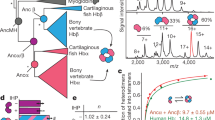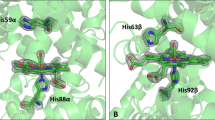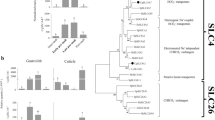Abstract
CROCODILES are able to remain under water for more than one hour without surfacing to breathe1,2 and often kill their prey by drowning it. How do crocodiles stay under water for a long time? When they hold their breath, bicarbonate ions, the final product of respiration, accumulate and drastically reduce the oxygen affinity of haemoglobin, releasing a large fraction of haemoglobin-bound oxygen into the tissues3,4. We have now located the bicarbonate-ion-binding site at the α1β2-subunit interface by making various human-crocodile chimaeric haemoglobins. Furthermore, we have been able to transplant the bicarbonate effect into human haemoglobin by replacing only a few residues, even though the amino-acid sequence identity between crocodile (Crocodylus niloticus) and human haemoglobins is only 68% for the α- and 51% for the β-subunit5. These results indicate that an entirely new function which enables species to adapt to a new environment could evolve in a protein by a relatively small number of amino-acid substitutions in key positions6.
This is a preview of subscription content, access via your institution
Access options
Subscribe to this journal
Receive 51 print issues and online access
$199.00 per year
only $3.90 per issue
Buy this article
- Purchase on Springer Link
- Instant access to full article PDF
Prices may be subject to local taxes which are calculated during checkout
Similar content being viewed by others
References
Cott, H. B. Trans. Zool. Soc, Lond. 29, 211–356 (1961).
Andersen, H. T. Acta physiol. Scand. 53, 23–45 (1961).
Bauer, C. & Jelkmann, W. Nature 269, 825–827 (1977).
Bauer, C. et al. J. biol. Chem. 256, 8429–8435 (1981).
Leclercq, F., Schnek, A. G., Braunitzer, G., Stangl, A. & Schrank, B. Hoppe-Seyler's Z. physiol. Chem. 362, 1151–1158 (1981).
Perutz, M. F. Molec. Biol. Evol. 1, 1–28 (1983).
Fermi, G. & Perutz, M. F. Atlas of Molecular Structure in Biology 2: Hemoglobin & Myoglobin (Clarendon, Oxford, 1981).
Kooyman, G. L. Diverse Divers Physiology and Behavior (Springer, Berlin, 1989).
Perutz, M. F. et al. Nature 291, 682–684 (1981).
Tame, J. R. H. thesis, Univ. Cambridge (1989).
Perutz, M. F. Nature 228, 726–734 (1970).
Monod, J., Wyman, J. & Changeux, J.-P. J. molec. Biol. 12, 88–118 (1965).
Grigg, G. C., Wells, R. M. G. & Beard, L. A. J. exp. Biol. 175, 15–32 (1993).
Kimura, M. Sci. Am. 241, 94–104 (1971).
Ikemura, T. J. molec. Biol. 158, 573–597 (1982).
Wells, J. M., Vasser, M. & Powers, D. B. Gene 34, 315 (1985).
Hoffman, S. J. et al. Proc. natn. Acad. Sci. U.S.A. 87, 8521–8525 (1990).
Komiyama, N. H., Shih, D. T.-B., Looker, D., Tame, J. & Nagai, K. Nature 352, 349–351 (1991).
Imai, K. Meth. Enzym. 76, 438–449 (1981).
Author information
Authors and Affiliations
Rights and permissions
About this article
Cite this article
Komiyama, N., Miyazaki, G., Tame, J. et al. Transplanting a unique allosteric effect from crocodile into human haemoglobin. Nature 373, 244–246 (1995). https://doi.org/10.1038/373244a0
Received:
Accepted:
Issue Date:
DOI: https://doi.org/10.1038/373244a0
This article is cited by
-
Biophysical reviews ‘meet the editor series’–Jeremy R. H. Tame
Biophysical Reviews (2021)
-
A genomics approach reveals insights into the importance of gene losses for mammalian adaptations
Nature Communications (2018)
-
Purification, Characterization, and Crystallization of Crocodylus siamensis Hemoglobin
The Protein Journal (2014)
-
Molecular Cloning and Expression of α-Globin and β-Globin Genes from Crocodile (Crocodylus siamensis)
The Protein Journal (2013)
-
Genome analysis and signature discovery for diving and sensory properties of the endangered Chinese alligator
Cell Research (2013)
Comments
By submitting a comment you agree to abide by our Terms and Community Guidelines. If you find something abusive or that does not comply with our terms or guidelines please flag it as inappropriate.



